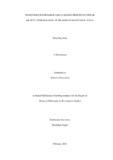
Please use this identifier to cite or link to this item:
https://hdl.handle.net/20.500.14301/400| Title: | Indigenous knowledge and learning process in Newar society: Ethnography of sīkahmi of Bhaktapur, Nepal |
| Authors: | Gosai, Saroj Raj |
| Citation: | Gosai,S.R.(2022).Indigenous knowledge and learning process in Newar society: Ethnography of sīkahmi of Bhaktapur, Nepal |
| Issue Date: | Jan-2022 |
| Publisher: | Kathmandu University School of Education |
| School: | SOED |
| Department: | DODE |
| Level: | M.Phil. |
| Program: | MPhil in Development Studies |
| Abstract: | Sīkahmi (Silpakār), a Newar caste group in Kathmandu Valley, has deep knowledge and skills in making woodcrafts and structures, applying their centuries- old skill. The structures they made could resist big earthquakes as well. With this fact, that ancient art was explored to find out the knowledge, skill, opportunities and challenges associated with it. Participant Observation, in-depth interviews, and meetings with experts were the tools used to collect data. The data were analyzed under different themes and were interpreted by applying Bandura's social learning theory, experiential learning theory of Carl Roger and social constructivism of Vygotsky. The Sīkahmis know a lot on wood and its uses. They also know how to construct earthquake-resistant buildings. They have deep knowledge of art and craft, science and technology and architecture. The Sīkahmis transferred their ancestral skills in Āga (n), the house to orient and impart knowledge to the lineage of Sīkahmi. Education is given by the priest in secrecy to perform various ritual activities. They have Thyā-safū (Folded book) to ii teach the carpentry designs. This book has the sketches and designs of the monuments and woodcarvings on the basis of Vāstu-Shāstra. A woodcarver seriously observes his seniors and tries to emulate them. Although this art is related to their livelihood, this is their contribution to the society and country. Many of the artists are self-employed and get good income. They are highly honored by the local people. Retention and transfer of this art is not without challenges. The challenges are: less interest in traditional occupation in new generation, more inclination of youth towards modernity, escalating cost of wood and low-quality of wood in the market. I found Bandura's theory is aptly fitted in learning wood-carving; Jean Piaget's theory is well applied by Sīkahmi while solving their problems; John Dewy's theory was well fitted to know learning in socio-familial settings; and social constructivism of Vigotsky were found applicable in reflecting, evaluating and reconstructing Sīkahmi's knowledge and skill transfer practices. Finally, I concluded that Sīkahmi's knowledge can be included in the school curriculum. Once it will be done Sīkahmis can be tutors, thus bridging the gap between generations. |
| URI: | https://hdl.handle.net/20.500.14301/400 |
| Appears in Collections: | Dissertations |
Files in This Item:
| File | Description | Size | Format | |
|---|---|---|---|---|
| Dissertation - Saroj Raj Gopsai final.pdf | 2.11 MB | Adobe PDF |  View/Open |
Items in DSpace are protected by copyright, with all rights reserved, unless otherwise indicated.